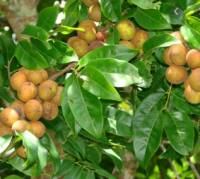Pitomba
| Botanical Information |
| Order | Sapindales |
| Family | Sapindaceae |
| Genus | Talisia |
| Common Name | Pitomba |
| Species | T. esculenta |
Maturity days
Planting Months
| Planting months |
| Jan | Feb | Mar | Apr | May | Jun | Jul | Aug | Sep | Oct | Nov | Dec |
| X | X | X | X | X | X | X | X | X | X | X | X |
Permaculture uses
| Permaculture uses |
| Usage 1 | Usage 2 | Usage 3 |
| | Food_Forest | Fruit |
| Growing Condition | Comment |
| Drought Tolerant | No |
| Humidity tolerant | Yes |
| Planting area | Ground |
| Sunlight | Full_sun |
Photos
Talisia esculenta is a medium-sized tree native to the Amazon Basin, and is found in Brazil, Colombia, Peru, Paraguay and Bolivia. The tree and fruit are called pitomba in English, Spanish and Portuguese, cotopalo in Spanish, pitoulier comestible in French and olho de boi, pitomba-rana and pitomba de macaco in Portuguese. Pitomba is also used as the name for Eugenia luschnathiana. Talisia esculenta can grow to a height of 9–20 m, with a trunk up to 45 cm diameter. The leaves are arranged alternately, pinnately compound, with 5–11 leaflets, the leaflets 5–12 cm long and 2–5 cm broad. The flowers are produced in a panicle 10–15 cm long, the individual flowers small and white. The fruit is round to ellipsoid in shape, 1.5–4 cm in diameter. Beneath the outer peel is the white, translucent, sweet-sour pulp with one or two large, elongated seeds. The fruit is eaten fresh and used to make juice. The sap is used as a fish poison. Roasted seeds are used to treat diarrhea.
